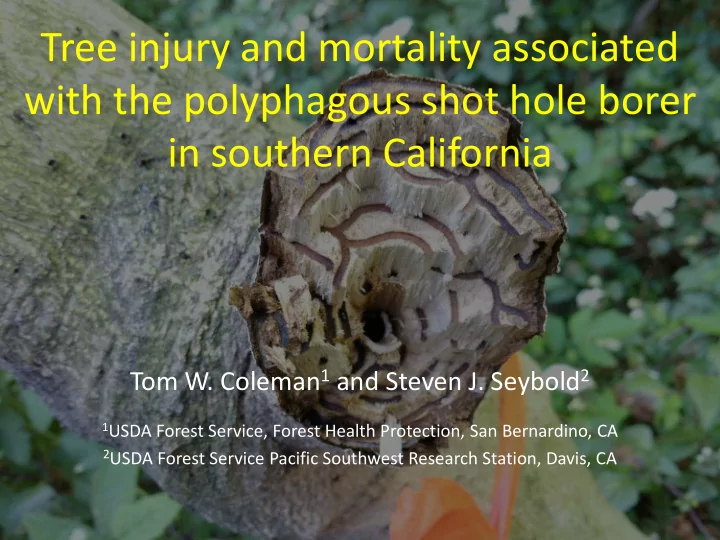

Tree injury and mortality associated with the polyphagous shot hole borer in southern California Tom W. Coleman 1 and Steven J. Seybold 2 1 USDA Forest Service, Forest Health Protection, San Bernardino, CA 2 USDA Forest Service Pacific Southwest Research Station, Davis, CA
Polyphagous shot hole borer (PSHB), Euwallacea sp. CA FL First detected in California in 2003 • – Whittier Narrows Recreation Area (LA Co.). This insect/disease complex was not linked to tree injury and mortality until 2012 in LA Co. PSHB in California was believed initially to be the tea shot hole borer, • Euwallacea fornicatus , which had been introduced into Florida Recent molecular analyses suggest that the CA species of Euwallacea • may be a new species (R. Stouthamer Laboratory, UCR) – The same species attacks hardwood trees and shrubs in Israel
Polyphagous shot hole borer (PSHB) and Fusarium dieback ( Fusarium euwallacea) • Polyphagous shot hole borer, Euwallacea sp. – Similar to tea shot hole borer in FL • Fusarium dieback, Fusarium euwallacea – Same insect-disease complex found in Israel
Current distribution of PSHB in CA • El Cajon (San Diego Co.): Recent detection of PSHB
Polyphagous shot hole borer An ambrosia beetle • Length: Females ~2.6 mm; Males ~ 1.1 mm • Sex ratio highly skewed toward females • Sibling mating occurs in galleries • Males are flightless; rarely leave galleries • Two to four gen/yr
PSHB entrance/emergence holes Sycamore Box elder Coast live oak Box elder Attacks found • from the root collar to smaller branches
PSHB injury symptoms • Dark-colored bark staining, gumming, and sugaring • Attacks frequently observed on the main stem and larger branches
PSHB injury symptoms • White- and tan-colored boring dust • Can appear as string-like projections from the tree • Boring dust observed frequently at the base
PSHB injury symptoms • Crown dieback and thinning • Epicormic and basal sprouting
PSHB injury symptoms • Branching dark-stained galleries • Galleries can penetrate to a depth of 8 cm into the xylem
Tree mortality associated with the PSHB • Observed tree mortality – Box elder – Castor bean – Red willow – California sycamore – English oak – White alder • Significant branch dieback/failure – English oak – Coast live oak – Avocado
Fungi associated with PSHB • An new species of Fusarium and Graphium associated with Euwallace a sp. – Eskalen (UCR) is conducting virulence tests with each fungus • The same Fusarium euwallacea is found in CA and Israel
PSHB hosts -primarily ornamental species 1. Box elder , Acer negundo 2. Castorbean, Ricinus communis 3. Avocado , Persea americana 4. English oak , Quercus robur 5. Coast live oak , Quercus agrifolia 6. California Sycamore , Platanus racemosa 7. Big leaf maple , Acer macrophyllum 8. Mimosa , Albizia julibrissin 9. Coral tree , Erythrina corallodendon 10. Titoki , Alectryon excelsus 11. Blue palo verde , Parkinsonia florida 12. Tortuosa , Salix matsudana 13. Weeping willow , Salix babylonica 14. Red willow, Salix laevigata 15. Trident maple, Acer buergerianum 16. Japanese maple , Acer palmatum 17. Evergreen maple , Acer paxii 18. Chinese holly , Ilex cornuta 19. Brea, Cercidium sonorae Host susceptibility varies • 20. Black bean , Castanospermum australe 21. Camellia , Camellia semiserrata 22. Cork oak, Quercus suber Will attack numerous hardwood • 23. Valley oak , Quercus lobata species, but can’t develop in these 24. Engelmann oak, Quercus engelmannii trees 25. White alder, Alnus rhombifolia
Why are we concerned about PSHB in CA? • PSHB attacks avocados • California produces 90% of the nation’s avocado crop • ~21,000 ha of avocados planted from San Luis Obispo to San Diego • Crop valued at $382,000,000/yr • And, avocados taste good
Native hardwood stands in southern California
PSHB also attacks and kills our native riparian trees Red willow White alder California sycamore
Summary • PSHB is already impacting the native hardwood stands of southern California and the urban areas – Loss of hardwood stands can impact wildlife and threatened and endangered species – Willow flycatcher, bell vireo, Arroyo toad, yellow- legged frogs, western yellow-billed cuckoo, gray vireo, 3 bat species, and 6 snake species • Its impact may be more prevalent in lower elevation hardwood stands on California sycamore, castorbean, and willow spp. – All size classes appear to be susceptible
PSHB information www.cisr.ucr.edu
Recommend
More recommend